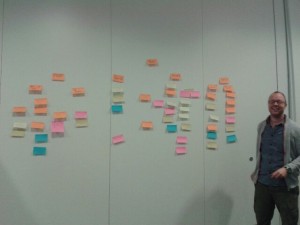On Dec 1, ice2ice held a science planning meeting at Park Inn Hotel near Copenhagen airport. It is a nice venue easily accessible for visitors flying in for meetings. For the ice2ice crowd, it was extra fun to come back, since this was where we had the rehearsal meeting for the final grant interview about a year ago. The meeting was planned mainly as a DMI-team workshop but we had guests Anne Solgaard (CIC) and Qiong Zhang (Bert Bolin Centre in Stockholm) to inspire and spur on the discussions.

Guided by the original application and new opportunities that have arisen, we worked through the day on crystallizing our ideas and wishes into actual projects and experiments. Along the way we had time for talks by Qiong Zhang (on the paleo-modeling with EC-Earth in Stockholm), Shuting Yang (on a Global Climate Model (GCM)-view on the reversibility of Arctic sea ice loss) and Rasmus Anker Pedersen (on local and remote influences of sea ice loss in the Atlantic and Pacific parts of the Arctic).
Lots of ideas came up, most of which had a direct bearing on the ice2ice goals. A couple of tools were identified to be central to many of the experiments that we want to conduct. One is the capability to nudge the sea ice field, subsurface temperatures, and near-surface salinities in the fully coupled EC-Earth. This will allow us to perform sensitivity experiments focusing on the response of the atmosphere-ocean-ice sheet system to changing conditions in the Arctic associated with sea ice cover, Atlantic inflow, freshwater runoff and brine rejection. Furthermore, an ultra-high resolution setup of our regional model system will allow us to study details of the climate in areas characterized by steep topography such as the Scoresbysund-Renland region. We also decided to investigate the possibility of running the EC-Earth at a high resolution allowing for an adequate representation of the forcing fields to drive a full Northern Hemisphere ice sheet model.